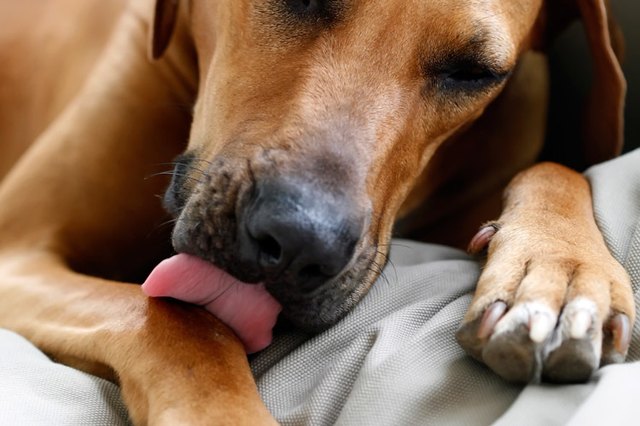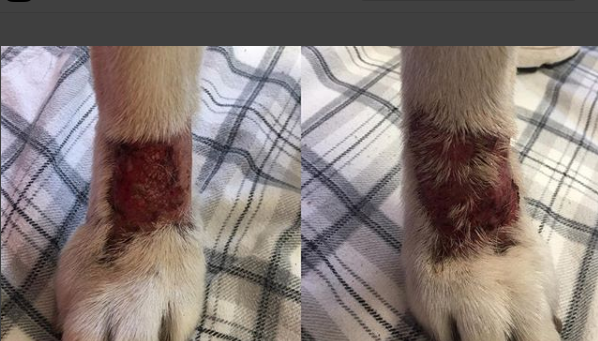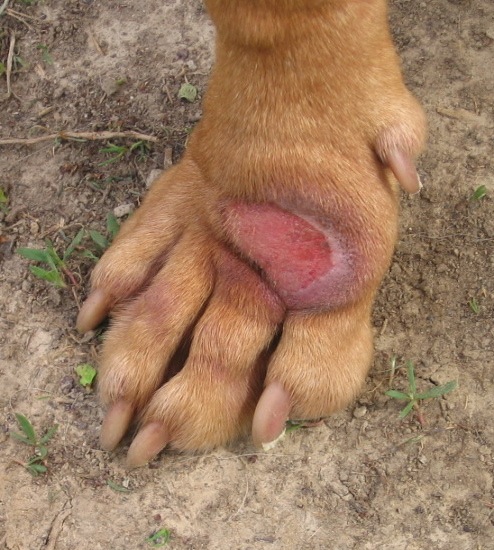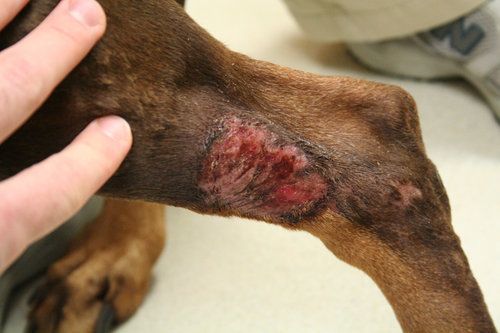| print
link to this post | email a friend Licking and chewing on a limb… Maybe not habitual or a skin infection after all!14 Feb 2019 By Laurie Edge-Hughes, BScPT, MAnimSt (Animal Physio.), CAFCI, CCRT
Does your dog lick or chew at a foot or one particular patch of skin? Does it suck on its back feet? Do you notice that there is a patch of skin or one or two paws that are a bit pink in colour? Is there an area where your dog’s hair is slicked down or a bit crusty from saliva? Does your dog have a lick granuloma that you and your vet are struggling to treat? Well then, you need to keep reading!
Firstly, let’s talk about nerves. Nerves supply motor and sensory information to and from the spinal cord, brain, and any other part of the body. They typically slide along the tracks that they run, and are accustomed to getting stretched, tweaked, and sometimes pinched. Most of the time, they’re pretty resilient. However, if a pinch or stretch goes on for too long or happens over and over and over again, then that nerve can get inflamed. Inflammation to a nerve is where things go awry and is the gist of this blog!
When a nerve is inflamed, it can cause the signaling to go haywire. Messages out from the brain and spinal cord can be ‘over-signaled’ or inappropriately signaled. One thing that can happen with a pinched / inflamed nerve is that it can produce a pins and needles sensation. Quite likely you’ve experienced this at some point in your own body! Other time, it can create a numbness, whereby the sensation in an area is compromised. (Now is a good time to test all of your fingertips to see if they are all experiencing the same sensation… once I found that a side of one of my fingers was numb and I didn’t even know it.)
What do you think a dog would do if he/she were experiencing a pins and needles sensation in a leg or a foot? It’s not crazy to think that their first instinct would be to lick it, chew it, or bite at it. Sometimes they can lick at an area so much that the skin reacts and an aggravated hairless wound is created (a lick granuloma). Typically, veterinary medicine will look at licking and chewing or these lick granulomas as being a result of allergies, a minor irritation, joint or bone pain, an infection, boredom, stress, or anxiety related. Sometimes that’s true. However, veterinarians will often state that lick granulomas are very difficult to treat. Part of the reason for that is that they might be treating the wrong thing!
There are a handful of papers out there on the subject of lick granulomas and pinched nerves. My favourite is an article that provided researched data showing that 56% of cases of lick granulomas could be correlated with nerve conduction deficits. What does that mean? It means that in those cases, the nerve that supplied the limb was compromised in some way, thus affecting its ability to transmit information. This is exactly what happens when a nerve is pinched.
Now, for those of you research nerds out there (like me), here are some of the papers:
We see this problem commonly at The Canine Fitness Centre Ltd as well! In fact, whenever we see evidence of licking (slicked hair in an area, a hairless patch, a skin wound, or pinkish-rust coloured hair), we always check the spine! Neck issues, and upper thoracic spine and rib problems can cause abnormal sensations in the front legs, and lumbar spine and sacroiliac joint troubles can cause abnormal sensations in the rear legs. If the problem is in all 4 limbs, then it’s not likely a pinched nerve! It’s more likely to be an allergy in that case. Occasionally, we have even seen issues in the middle of the back, such as a hairless patch, an area of more dander, or just thinner hair. This too can be the result of a pinched nerve (it’s just that a dog can’t get to that region to lick!)
The great news is that all of the therapists here at The Canine Fitness Centre are highly trained in manual therapy. We use mobilizations to move the spinal joints and open up the joint spaces, thus freeing the pinched nerve. Mobilizations have been shown to be just as effective as spinal manipulation, and are gentler and often better at helping to enhance blood flow to an area (which can help to dissipate inflammation faster). Beyond the manual therapy, you’ll find we typically laser the spine and the area of the licking (especially if the dog has created a wound). The laser helps with reducing the inflammation, settling down pain, and healing wounds. Then, if appropriate we will show you how to traction your dog’s spine. This can really help to speed up healing and gives you something that you can do to help the situation at home. All in all, it’s a comprehensive plan!
So, if you have a dog that is licking or chewing at a limb, think about bringing your dog in for a physio evaluation. It could save you tons of money and aggravation in the long run!
|

|




